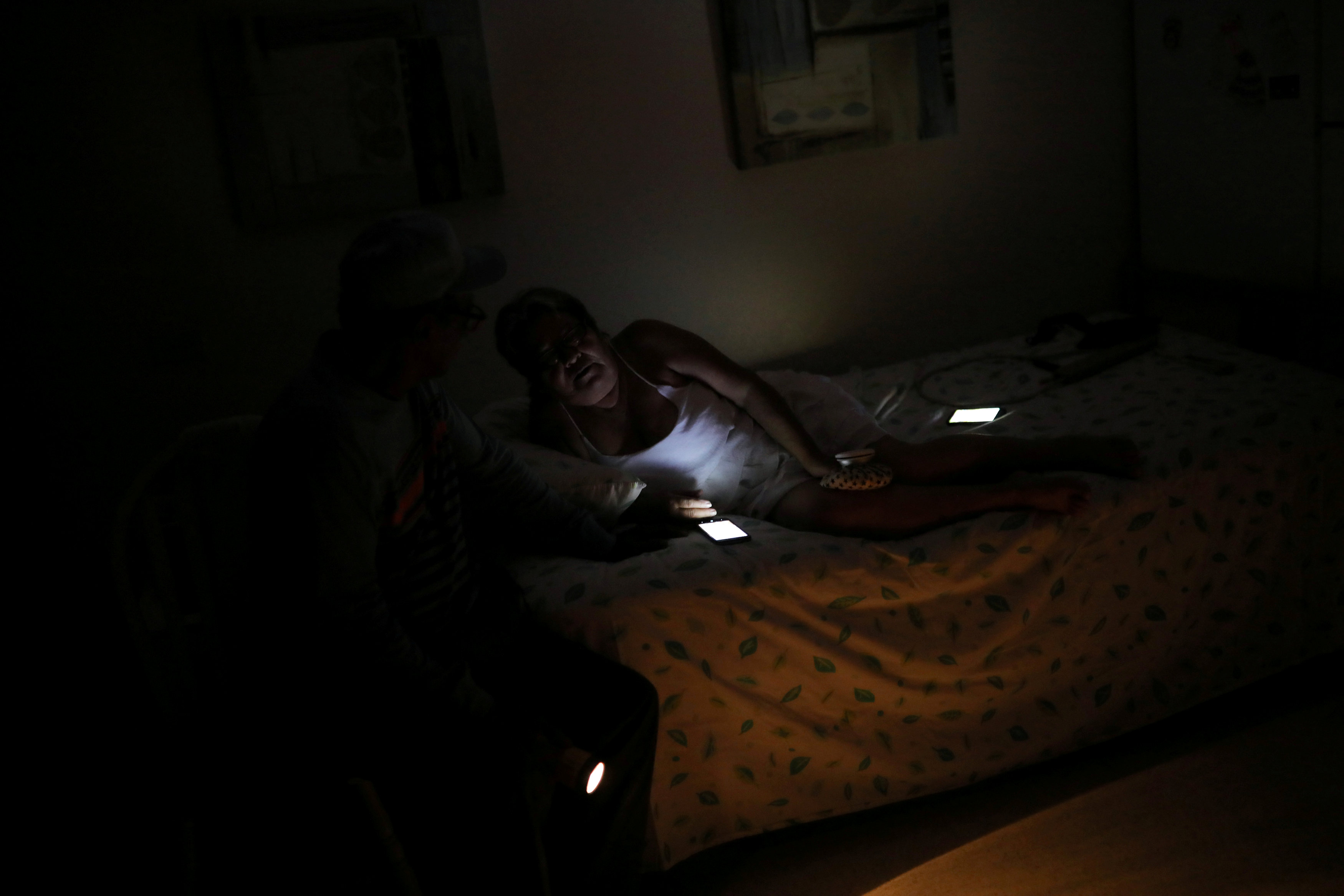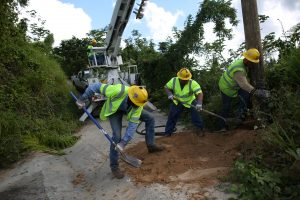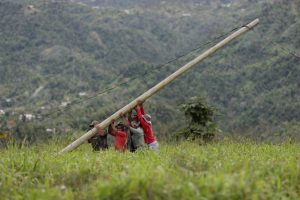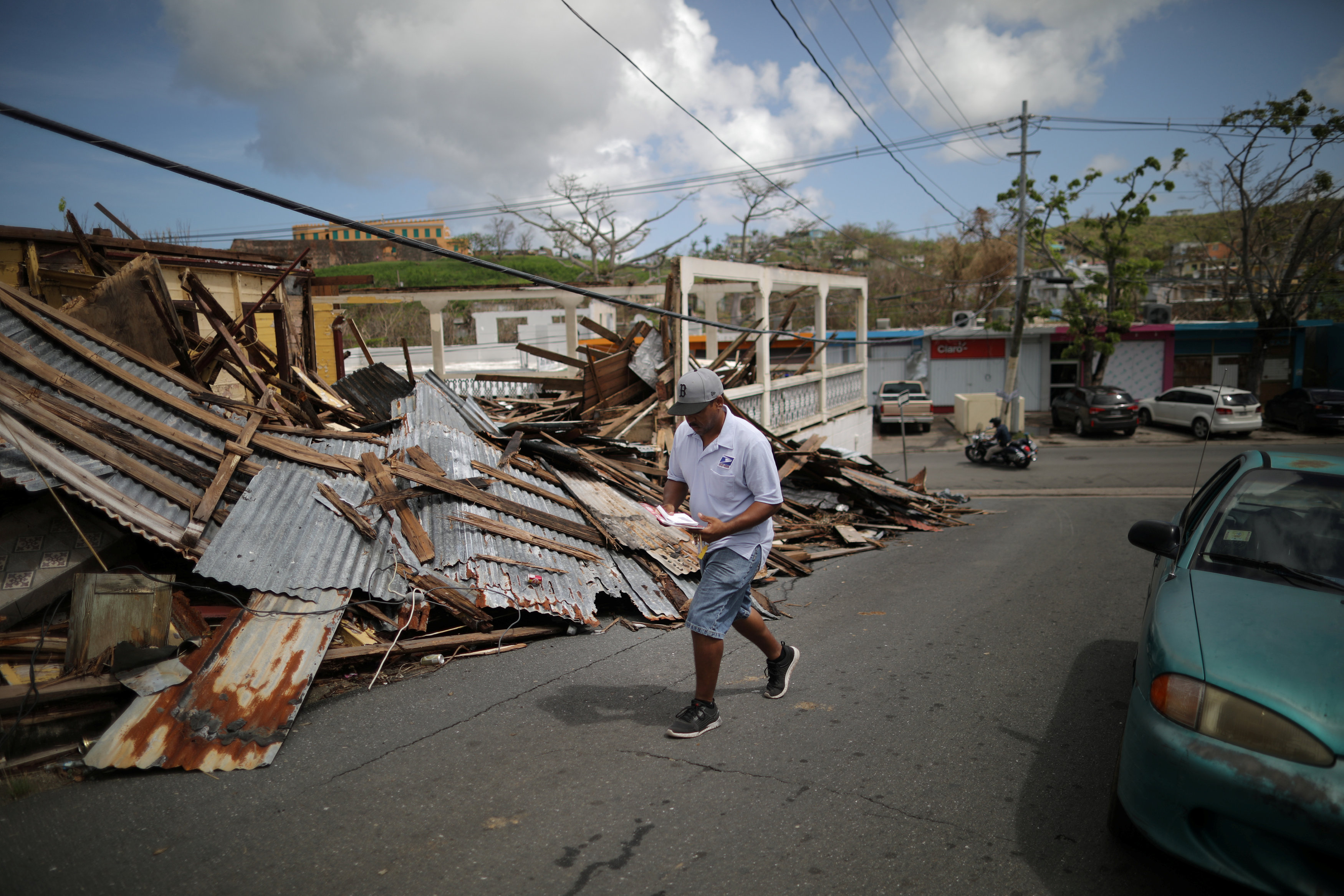
By Nick Brown, Robin Respaut and Jessica Resnick-Ault
SALINAS, Puerto Rico/NEW YORK (Reuters) – In the rural village of Salinas in southern Puerto Rico, frayed electric lines hanging from a utility pole blew in the breeze last week near the town square.
But the damage didn’t come from Hurricane Maria.
“Those wires were actually there before,” said Fermin Seda, 68, a Salinas resident who said he has grown accustomed to downed lines and power outages.
Two weeks after the storm plunged the island into a blackout, less than 10 percent of Puerto Rico’s 3.4 million people have seen power restored – and many will wait months.
Restoring the grid after the worst storm to hit here in nine decades would be a monumental task even for a well-run utility. It will be much harder for the chronically underfunded Puerto Rico Electric Power Authority (PREPA), which went bankrupt in July amid mounting maintenance problems, years-long battles with creditors, a shrinking workforce and frequent management turnover.
For graphic on slow restoration of power after Maria click: http://fingfx.thomsonreuters.com/gfx/rngs/STORM-MARIA-POWER/010050ZK27Z/index.html
For graphic on PREPA’s aging power plants, dwindling workforce click: http://fingfx.thomsonreuters.com/gfx/rngs/USA-PUERTORICO-UTILITY/0100512E2EX/index.html
Interviews with more than two dozen officials and consultants who work for or with the U.S. territory’s government, PREPA or its creditors reveal a utility that was unprepared for a major storm despite the ever-present risk to this Caribbean island. When Maria hit, PREPA was trying to simultaneously finance an operational overhaul and dig out from about $8 billion in debt.
Puerto Rico Governor Ricardo Rossello, in an interview with Reuters on Saturday, said none of the utility’s storm response plans could account for years of poor maintenance of the dilapidated electric network.
“The emergency plan was as follows: There is no way to fix the nature of the grid,” Rossello said.
He added that the network was so feeble it would have collapsed even in a much weaker storm than the one that hit Puerto Rico at Category 4 wind strength – the second highest level in the five-tier U.S. storm gauge.
“If you have an old grid susceptible to collapse, there is no way – until you change it completely – that it can sustain the winds of a Category 4, or even really a Category 2,” the governor said.
CHRONIC WEAKNESSES
A host of chronic problems at PREPA left the island’s electric grid vulnerable to collapse in a major storm, Reuters found. They include:
* Frequent turnover in management and board leadership,which has long failed to prioritize grid maintenance, accordingto reports prepared in 2015 and 2016 for utility regulators bythe consultancy Synapse Energy Associates. The deferred upkeep,according to a PREPA assessment in April, led to a “degraded andunsafe” grid that needed at least $4 billion for modernizationof an “isolated system, in challenging terrain” that is “subjectto natural atmospheric events.” * Falling revenues that failed to cover operating expensesbecause of poor collection of utility bills and declining energysales through a decade-long recession. * A lack of regulatory oversight prior to 2014, and a roughtransition of power from former utility board members andofficials to a new energy commission created that year bylegislation, with little handoff of disaster-preparedness plans. * A staff diminished from 8,628 workers in 2012 to 6,042this year, according to the April PREPA report. The talent drainreflects a larger exodus of residents from Puerto Rico -especially skilled workers – as the U.S. territory lost 300,000people, or 8 percent of its populace, between 2010 and 2016,according to U.S. Census data.Ricardo Ramos, who took over as the utility’s chief executive in March, told Reuters that the number of employee departures over the past five years is actually closer to 4,000 – with the vast majority being key operational workers such as linemen, power plant operators and mechanics.
They were exactly the kind of workers the utility couldn’t afford to lose.
“PREPA did not invest in new power plants or new generation, so our power plants are very, very old; our distribution system is very, very old,” Ramos said in an interview on Monday.
One pivotal question now is whether the United States will work merely to patch the existing network or allocate billions of dollars in federal funds to overhaul it. The government is open to spending money on modernization, Homeland Security Advisor Tom Bossert said at a briefing last week.
The White House did not respond to Reuters’ inquiries seeking comment on the short- and long-term U.S. roles in restoring power to this U.S. territory.

FILE PHOTO: A woman chats with a neighbour at the Moradas Las Teresas Elderly House, where about two hundred elderly people live without electricity following damages caused by Hurricane Maria in Carolina, Puerto Rico, September 30, 2017. REUTERS/Carlos Barria/File Photo
‘THE LONG HAUL’
The Federal Emergency Management Agency (FEMA) told Reuters that the agency is “in this for the long haul” but offered no details on the level of funding it could commit to the island’s power grid.
Citizens of Puerto Rico do not receive services equal to U.S. states but also do not pay federal income tax.
The collapse of the grid isn’t the only cause of the island’s suffering. The U.S. relief effort so far has been unable to supply Puerto Rico with all the fuel it requires, for instance, leaving motorists waiting in long gasoline-station lines and depriving many backup electricity generators of diesel.
The lengthy electrical outages are a bitter pill for storm victims, who before Maria had already endured frequent service interruptions and rates higher than any U.S. state except Hawaii, according to PREPA and the U.S. Energy Department.
The impacts go well beyond temporary discomfort. The lack of power has been a key factor in a humanitarian crisis as residents with no refrigeration for food and medicine scrambled to find open stores and waited in endless lines.
In Salinas, 54-year-old Maria Sanchez wept as she threw out all of the food inside her mother’s fridge. By Saturday, she and six family members were surviving on crackers after eating all the other non-perishable food in the house.
“We are not rich – to throw away food like that. We’re running out of food – like fast,” she said, sitting on the porch, where a mild sea breeze offered little reprieve from the oppressive heat.
Diabetic Nancy Rivera lost more than food.
“All of my insulin is ruined,” said Rivera, 59, of Santurce, a district in San Juan, who stopped taking her spoiled medicine four days after the storm.
‘TRIAGE’ OF GRID REPAIRS
Winds of up to 155 mph (250 km/hr) during Maria knocked out about 80 percent of PREPA’s distribution network, said Ramos, the utility’s chief executive. Since the storm, power has been limited to key locales such as hospitals and hotels using generators fueled with a scarce supply of diesel.
Damage assessment for the grid, usually completed within 48 hours of a hurricane in the mainland United States, took a week-and-a-half, Ramos said. The assessment went as fast as possible given the widespread damage, he said, and the utility had three working helicopters to survey the network.
FEMA last week put the U.S. Army Corps of Engineers – often tasked with infrastructure projects – in charge of short-term power restoration, in coordination with the Energy Department, the American Public Power Association and the New York Power Authority.
Gil Quiniones, CEO of NYPA, said the Army Corps had asked his utility for experts in power systems – which isn’t a Corps specialty – who can “think strategically on how to triage the situation and how to prioritize the work.”
The task is made more daunting by the island’s ill-maintained infrastructure. And PREPA’s strapped finances mean it cannot keep large standing orders for full-scale repair operations to swarm in after disasters, as utility repairman did last month in Florida after Hurricane Irma.
Ramos said PREPA has about 30 days worth of existing supplies for repairs following a storm; more is being ordered, to arrive in the next few weeks, he said.
‘THEY CAN’T TELL ME HOW LONG’
On the south side of Puerto Rico, near most of the island’s power plants, broken wires and blackouts were common before Maria.
“They tell me that right now, they’re evaluating damage to the power grid in our region,” Salinas Mayor Karilyn Bonilla said on Friday. “And they can’t tell me how long that will take.”
Bonilla said she has seen workers remove a few transformers since Maria hit but no one fixing downed power lines.
The amount of time power plants were down due to unplanned outages, measured in megawatt hours, more than doubled between mid-2015 and mid-2016, according to Synapse, the consultant firm.
By summer 2016, residents were experiencing four to five times the number of outages as the average U.S. customer, the consultants wrote.
The system’s deficiencies were laid bare in September 2016, when a transformer fire knocked out half of the island’s power, which wasn’t fully restored for nearly a week, forcing the governor to declare a state of emergency.
“Basically it was what you can call an unfortunate set of events, but really it is what I have said since I began at PREPA: lack of maintenance,” Ramos said.
One of the biggest factors in the outages: a constantly shrinking staff, driven away by costly medical benefits and unsafe conditions. The utility’s April report notes PREPA had a greater-than-average number of safety incidents for U.S. utilities, with more than 14,000 accidents and 15 fatalities in a 10-year period.
Many workers left for better opportunities, Ramos said. Because Puerto Ricans are American citizens, they face no legal barriers in leaving the island for the mainland.
“The truth of the matter is they make a lot more money in the U.S.,” said Ramos.
FIGHT FOR CONTROL
U.S. utilities are regulated by the states in which they operate, and by the U.S. Federal Energy Regulatory Commission if they operate across state lines. U.S. federal oversight of PREPA is limited to environmental and safety standards and does not cover the transmission network.
Unlike utilities in U.S. states, PREPA had no regulator for decades and essentially governed itself. In 2014, the Puerto Rico Energy Commission was created by the island’s legislature, which sought greater oversight in response to perceived neglect by PREPA’s leadership at the time, which resisted the intervention.
Weeks after the act passed, PREPA became insolvent.
Today, the political squabbling over control of PREPA – and blame for its problems – continues even as utility officials respond to a historic crisis.
Ramon Luis Nieves – former head of Puerto Rico’s senate energy committee and a champion of the 2014 legislation – blasted former utility officials for poor oversight in an interview last week.
“Using their powers of self-regulation, PREPA itself was judge and jury,” he said as he waited in a five-hour gasoline line.
Energy Commissioner Angel Rivera said former PREPA officials gave the new regulator nothing in the way of disaster plans.
“If PREPA did any sort of analysis like this when they were creating the system, we would not know,” said Rivera, who was appointed in November 2014.
PREPA also fought the commission’s requirements to integrate renewable energy, said Nieves, the former senator. The commission rejected the utility’s first long-term plan to create a more reliable, cost-effective grid as inadequate, according to commission records.
Attempts by Reuters to reach PREPA’s previous chief executive, Javier Quintana, were unsuccessful.
Ramos – Quintana’s successor and a former engineer and PREPA employee – said he agreed with the need for an oversight commission when it was formed. But he now believes the commission wields too much power, citing its pushback on the utility’s capital spending.
“I basically have no power,” he said. “Basically, they wanted to run PREPA except during a hurricane, because now they are nowhere to be found.”
Jose Roman, interim chairman of the energy commission, disputed the notion that the commission wanted to run the utility, saying it only aimed to protect customers.
YEARS OF REBUILDING AHEAD
What remains unclear is the level of commitment from FEMA, the Army Corps and U.S. utilities for longer-term upgrades to buttress the system against future storms.
Bossert, the U.S. Homeland security advisor, said on Sept. 28 that the power grid would have to be rebuilt, “so we’re going to put federal money into this.”
The costs will be steep: The $4 billion estimate for modernization from PREPA does not include additional damage from Maria.
The task will be complicated by PREPA’s battles with creditors, who are led by hedge funds and mutual funds. The parties had been in debt restructuring talks for three years before the agency filed for bankruptcy in July.
A group of PREPA’s largest creditors, which include Franklin Advisers, Oppenheimer Funds and BlueMountain Capital, offered a loan of $1 billion after the hurricane. The island’s fiscal oversight committee rejected the offer, calling it a “publicity stunt” and criticizing the repayment and interest terms as unfavorable.
A spokesperson for the creditors declined to comment on that statement but the investment firms’ advisor, investment bank Houlihan Lokey, earlier expressed disappointment that the proposed loan had been rejected without negotiation.
The utility had considered but not yet implemented a wide variety of infrastructure improvements when senior leadership turned over after Rossello became governor at the beginning of the year. The governor typically appoints PREPA’s board and executive director.
Now new honchos are starting over in assessing PREPA’s needs, a repeat of past leadership transitions.
In the summer of 2016, PREPA held its 2017 public budgeting proceeding – the first led by the island’s utility commission rather than the utility itself.
Amid the deep financial problems of the island’s government and the utility, the commission allocated about $400 million for PREPA to address maintenance and repairs for the year, Commissioner Rivera said. Overall capital improvement plans for 20 years come to $2 billion, according to commission consultant Synapse.
Even the long-term plan represents just a fraction of what will be needed, suggesting the grid overhaul will require a serious commitment from the United States. Discussions about that reality are starting now.
“There’s diverging sentiments on the role of U.S. funding,” said a private sector energy executive who is working with PREPA to fix the networks and has been involved in strategy discussions with officials from FEMA and Puerto Rico.
“That’s where things start to get stuck,” he said. “No one argues about a generator in a hospital, but that doesn’t get the lights in the houses turned back on. Nobody knows where the money is going to come from.”
(Reporting By Nick Brown and Robin Respaut in San Juan and Salinas, Puerto Rico, and Jessica Resnick-Ault in New York; Additional reporting by Scott DiSavino and Stephanie Kelly in New York and Roberta Rampton in Washington; Writing by David Gaffen and Jessica Resnick-Ault; Editing by Brian Thevenot)













